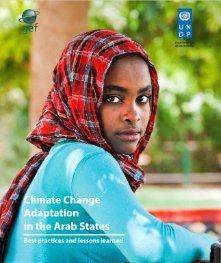Climate Change Adaptation in the Arab States
Climate Change Adaptation in the Arab States
July 26, 2018
In the Arab States, the causes of crises, food insecurity, malnutrition and vulnerability to climate change impacts are deeply interlinked and require multifaceted responses. The Arab region is home to rising levels of conflict and the world’s largest population of refugees and displaced people. Simultaneously, it is now the planet’s most water scarce and food-import-dependent region, and the only region where malnutrition rates have been rising. Over-exploitation of natural resources in the region has also led to severe ecosystem degradation. Poor land and water management are reducing the potential provision of already limited ecosystem services. The impacts of climate change are exacerbating the existing challenges of sustainably managing limited natural resources. Climate change-related desertification has expanded in the Arab region, greatly increasing the vulnerability of the local population. In fragile countries such as Somalia, illegal armed groups such as Al-Shabaab have increasingly attracted young people, who are affected by drought-induced food insecurity and have limited job prospects.
To conquer such challenges, UNDP is supporting countries in the four sub-regions of the Arab region (Mashreq, Maghreb, Arab Gulf and Horn of Africa) to adapt to climate change impacts and to prepare for disaster risks. These countries include some of the least developed countries (LDCs), namely: Djibouti, Somalia, Sudan, and the Republic of Yemen; Tunisia in the Maghreb; and the Arab Republic of Egypt, Iraq, Jordan, Lebanon and the occupied Palestinian territories in the Mashreq. UNDP projects have aimed to improve natural resource governance and management while balancing socio-economic needs and environmental protection. Currently, UNDP’s Climate Change Adaptation (CCA) portfolio includes two projects in Djibouti and Sudan in addition to single projects in Egypt, Somalia, Tunisia and Yemen. The first UNDP CCA project in the Arab region was launched in Egypt in 2010 with financing from the Global Environment Facility’s (GEFs) Special Climate Change Fund (SCCF). Since then, the portfolio includes ongoing projects with a total financing of approximately US$42 million, primarily financed by GEF, the Adaptation Fund (AF) and UNDP. Most recently, UNDP has also supported Egypt in accessing financing from the Green Climate Fund (GCF) for coastal adaptation. In parallel to GEF supported initiatives, UNDP has also supported Djibouti, Egypt, Iraq, Jordan, Lebanon, the occupied Palestinian territories, Somalia, Sudan and Tunisia in disaster risk reduction and recovery with projects from 2005-2016 valued at US$151 million, through support of UNDP resources and bilateral donors like Canada, the European Commission, Iceland, Japan, Kuwait, Switzerland and the US.
The purpose of this publication is to detail lessons learned from UNDP’s Climate Change Adaptation work and achievements in the Arab region on achieving sustainable and lasting results. Some lessons include building local capacity at all levels to ensure a project’s long-term viability, decentralizing infrastructure management, implicating community-based organizations, and promoting resilience of vulnerable populations through livelihood diversification. Providing populations with access to adapted financial services such as Weather Index Insurances (WII) linked with microfinance services was found to support rural populations to become more resilient to climate induced damages. The immediate objective of this publication is not only to share experiences with a wider audience, but also to inform future CCA programming. The publication furthermore acts as a call to action to facilitate a long-term coordinated approach to increasing the resilience of countries most vulnerable to climate change in the region.

 Locations
Locations